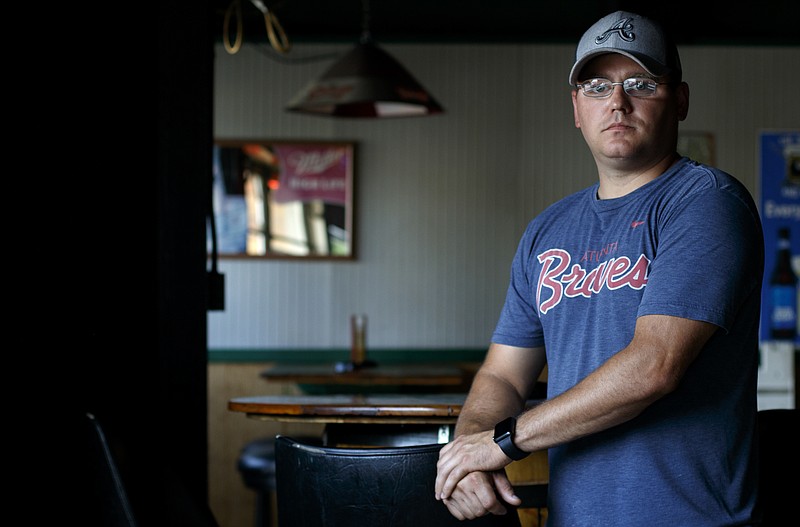ROSSVILLE, Ga. - The dark circles around his eyes told Mallorie Ellis that the strange man in her yard hadn't slept in days.
He paced back and forth under the porch light. He swatted at his sunken cheeks, like he was searching for a bug. He mumbled, then yelled.
"I'm going to kill Robbie!" she recalls him saying. "Where is he? I'm going to kill him."
"Why?" she asked. "What's going on?"
Ellis couldn't get an answer. She removed her glasses and squinted. "Jeremy?" she thought.
She had known Jeremy Little her whole life - but not like this. She knew the thick brick mason who lived a couple blocks north of the state line. The man in her yard had the same features. But he was skinny. And crazed.
She told Little that Robert William Ellis Jr., her ex-husband and the father of her two children, was not here, in a manufactured home community off Wilson Road. He hadn't lived here for about four months. Little should have known that.
After a couple of minutes, he hopped in his truck and left.
Mallorie Ellis and her roommate, Breanna Johnson, knew Robert Ellis used methamphetamine. Now, they knew Little used, too. They also knew the men would find each other soon.
About 16 hours later, on March 11, 2017, Little and Robert Ellis met in a yard off State Line Road. Little clutched a knife, Ellis a gun. Ellis tried to pistol whip him, but the gun went off, killing Little.
Staring at the body, Ellis lifted his hands to his head.
"If Robbie hadn't been on drugs, it would have been a fistfight," said Johnson, who has known Ellis since she was 6. " Robbie's not the violent person. Robbie's not the killing type."
***
To say methamphetamine is a problem in a poor community like Rossville, where the poverty rate is almost three times the national average, is not a surprise. But black market economics have made the problem even worse in the last five years, local drug detectives say.
The roots actually date back to 2005, when Congress tried to crack down on homegrown drug labs through the Combat Methamphetamine Epidemic Act. The law made it more difficult for people to buy bulk quantities of drugs like pseudoephedrine, a common precursor for methamphetamine.
The act worked, kind of. In 2005, members of the Lookout Mountain Judicial Circuit Drug Task Force found 128 meth labs. So far this current fiscal year, which ends in July, the task force hasn't found any. The circuit consists of Catoosa, Chattooga, Dade and Walker counties.
This reflects the country as a whole. According to the U.S. Department of Justice's latest National Drug Threat Assessment Report, released in October, the number of meth labs across the country is at a 16-year low.
And yet, there is more methamphetamine in the region than ever, said Pat Doyle, commander of the LMJC Drug Task Force. As the number of labs decreases in the United States, the amount of methamphetamine shipped in from Mexican drug organizations has increased.
"I don't think they saw all this stuff coming," Doyle said.
The amount of methamphetamine crossing the border has steadily increased since 2012, when U.S. Customs and Border Protection seized 14,100 pounds of the drugs. Last year, it seized 44,000 pounds, a 211 percent increase. That's a faster growth rate than what border patrol has seen with cocaine, heroin or marijuana during that time.
In turn, arrests for methamphetamine possession and trafficking have increased. According to the Tennessee Bureau of Investigation, officers in the state made 2,000 methamphetamine-related arrests five years ago. By 2016, they made 8,500 arrests for the drug.
According to the Georgia Department of Corrections, the number of offenders entering a state prison for methamphetamine-related offenses increased 46 percent from 2013 to 2017. This comes at a time when Gov. Nathan Deal fought to keep non-violent offenders out of prison.
During the same time period, the number of offenders entering for marijuana-related offenses dropped 19 percent; the number of offenders entering for cocaine-related offenses dropped 35 percent.
Drug use has become more deadly, too. In 2011, according to the Georgia Bureau of Investigation, 51 people in the state overdosed on methamphetamine. By last year, 247 people overdosed, more than for any other drug the agency tracks.
Unlike with local labs, where cooks worked for hours just to make a few ounces, Doyle said cartels have access to bulk supplies of precursor drugs.
In 2015, the British TV station Sky News released a documentary showing one organization's methods. Inside a lab reminiscent of Walter White's "Breaking Bad" peak, dozens of workers covered with gloves and face masks mixed chemicals in large drums. Clouds of toxic gas rose into the air.
When the chemicals formed methamphetamine, a team in another lab across town packed the drugs into small capsules and stuffed them into trailers. A third shipping team then moved the drugs north, toward the United States.
John McGarry, the resident agent in charge of the Drug Enforcement Administration's Chattanooga office, said organizations in hubs like Atlanta are seeing more methamphetamine flow in than ever. This drives the price down.
In 2014, he said an ounce of methamphetamine would have sold for $1,000. Now, investigators are seeing sales for $250-$350 an ounce. (Doyle, of the LMJC Drug Task Force, said he is seeing prices closer to $450 an ounce, though this could be because his team is tracking people further from the source of supply. The closer a drug gets to street level, the higher the price.)
"They're just getting it in, and they're trying to push it out as fast as they can," McGarry said of dealers in Atlanta. "They're expecting money back. And the cycle just repeats."
The result? Drug dealers in the tri-state area have more methamphetamine, too.
In March 2016, agents arrested Jamie Chuy in East Brainerd after finding $25,000 in cash and about 17 1/2 pounds of methamphetamine in his home. Chuy later told investigators he had bought about 88 pounds of the drug since the beginning of the year, according to a federal plea agreement. He said he bought methamphetamine for $280 an ounce and sold it for $510 an ounce.
Though there's no official data to back this up, McGarry believes Chuy's arrest may have been the single largest methamphetamine bust in Hamilton County history."
Then, in April 2017, agents surpassed it when they say they found about 20 pounds of methamphetamine in a hotel room where Matthew Turner was staying. Turner pleaded guilty as part of a federal conspiracy, in which investigators said his associates wired money to a source in Mexico directly.
In North Georgia, the drug task force hasn't made busts quite that big, Doyle said. But the investigators are finding dealers with much more methamphetamine than they used to. In January 2017, officers said they arrested Randall Rounsaville after finding about 9 pounds of the drug and $99,000 in his Ringgold home. (Rounsaville faces federal charges as part of an alleged conspiracy, which is still pending.)
In November, task force agents arrested Todd Harmon and Danyale Cooper on James Street with about 8 pounds of methamphetamine. Both pleaded guilty to trafficking charges in Walker County Superior Court last month. Cooper received a 10-year sentence; Harmon received a 15-year sentence. Both agreed to pay $200,000 fines.
"We used to get excited when we found over an ounce," Doyle said. "Now, we don't get excited until we find over a kilo."
***
Robert Ellis was able to hide his methamphetamine use better than most people, his family said. He wasn't the typical tweaker. He didn't stay out all night. He left the home to take a hit. When he returned, he ate and slept like everything was normal. Mallorie Ellis said she didn't even know he used the drug until they had been married for about two years.
But in the spring of 2017, the drug appeared to affect him differently. His cheeks became thinner. He seemed more agitated, Johnson said, like he lost his sense of humor. She wondered if he was smoking more methamphetamine - or some sort of different batch.
The drug impacted Jeremy Little much quicker. He looked unhealthy soon after he started using in 2016, and he stopped working as often as he used to. His best friend, T.J. Holland, the owner of The Brew & Cue, confronted him at the bar one day.
He said Little started to cry and promised to get clean. He stopped hanging around the bar much after that, though.
"It wasn't that he was mad at me," Holland said. "He didn't want to disappoint me."
Some friends warned Holland about Little's new girlfriend. They said she was a dealer, and many of her friends were allegedly heavy users. On March 10, 2017, Little's girlfriend and another woman returned home and told Little that Robert Ellis had pulled a gun on them. Apparently, Little's girlfriend approached Ellis' truck and startled him. He then pulled the gun and yelled at her. (Ellis later denied this story, telling the police he had never seen that woman in his life.)
That night, Ellis returned home to find the windshield of his Mustang broken. Someone slashed the tires, too. He also believed someone cut the brake line. A neighbor gave a description that matched Little's vehicle.
Later that night, he got a call from Mallorie Ellis, telling him that Little had shown up to her home, demanding to see him. Robert Ellis wanted revenge.
Around 8 a.m. the next day, he showed up at Little's girlfriend's home. He broke the windshield of Little's truck, smashed its windows and broke a window on the side of the home. He fired a shot through the back door. Little didn't come outside, and Ellis went home, expecting to get arrested.
About five hours later, when no officers showed up, he drove back to the home. As he drove down Rossville Boulevard, he later told police, he smoked a bowl of methamphetamine. At the house, he demanded that Little come outside. He said Little emerged with a knife.
"He had a look in his eye," Ellis later told police. "I had never seen it before."
He said Little lifted the knife, as if to cut him, although a surveillance video does not back that claim up. He said he tried to pistol whip Little in self defense. He said the shot just went off, unexpectedly. A detective asked him how often he used methamphetamine. He said every day.
About an hour later, in the dairy aisle of Food City, some friends called Mallorie Ellis on Facebook Messenger. They asked why Robert Ellis killed Little. She grabbed their 10-year-old daughter and 13-year-old son, began to cry and ran outside. Her children asked her what happened. She said their father killed a man. Her daughter screamed; her son turned white.
Back home, Robert Ellis drove up in his truck. She grabbed him by his shirt, yanked him out. The two lay on the ground together, crying. After a minute, she and her family helped lead him to a chair. He said goodbye to his children, knowing they may never see him as a free man again. (A jury convicted him of malice murder earlier this month. He will be sentenced June 19.)
Mallorie Ellis called the police, telling them that Robert was ready to turn himself in.
"I'm sorry" she recalls him yelling. "I just want to die! Oh Lord Jesus. Jeremy Little, forgive me."
Contact staff writer Tyler Jett at 423-757-6476 or tjett@timesfreepress.com. Follow him on Twitter @LetsJett.

